This was it – the start of our acclimatisation for the Inca Trail and Machu Picchu. We bussed it into Arequipa, where we had most of the day to spend exploring the pretty little town.
Our first stop was the Cathedral, which had lovely pulpits and altars imported from Europe. The town was founded in 1540 and the Cathedral was first constructed in 1544 and then again in 1549 after a fire caused terrible damage to it. The Cathedrals are the centre piece of these Peruvian towns as they were the first thing the spaniards arranged for construction to support the conversion of the locals to the catholic faith.
The museum in the Cathedral had a great collection of relics made of silver, gold, ivory and precious stones – we were all amazed by the lack of security for these treasures. The shine on the statues were apparently from the use of lambs bladder on them. We got to see the back of the large Cathedral organ, which was open for restoration – a rare sight.
There were some examples of bishops’ capes made of velvet and gold thread (weighing up to 25kg). The total get up of the bishops could weigh up to 65 kgs – I concluded they’re like the ‘firemen’ of the order. They even had a sweat band (I believe the correct name is a maniple) which was used to wipe the sweat from their faces.
We were then off to Museo Sanctuarios Andinos to see the famed ‘ice princess’ – Juanita. I can still remember hearing the news when the princess had been found back in 1995. Juanita, aged between 12 and 14, had been found in the Ampato Volcano – after her death more than 500 years earlier. Her death was likely the result of a sacrificial offering to the Apu (god) of the volcano by the Incan priests. It is believed that she would have understood her fate and considered it a great honour (believing it would offer her divinity).
Juanita was found frozen in the ice so is kept in a refrigerated glass cabinet for viewing – amazing more so because I didn’t realise this was something I would see on the trip. There have been four bodies found in total in the region that are believed to have been involved in sacrifices.
The white sillar (volcanic stone) constructed Santa Catalina Convent was the next stop. This convent was founded in 1579 housing cloistered nuns who would never to return to their families even if they decided to not proceed with their vows (shunned for their decision).
The convent operated like a little town in itself with streets between the nuns’ quarters (some evidently opulent due to the social status of some of the women before entering the convent). The convent was the first free school offered to the poor girls of the city providing instruction in music, writing, religious doctrine and choir.
The convent had been restored after a number of earthquakes but only opened to the public in 1970. Apparently 30 nuns are still living in the complex (obviously behind closed doors). I was impressed with the use of alabaster to create skylights for the very dark and damp cells of the nuns and the volcanic rock bowls which were used to filter the water into a pitcher below – took an hour per litre.
The next day we were off to the National Reserve of Salinas and Aguada Blanca. We passed the three volcanoes surrounding Arequipa – Misti, Pichu Pichu and Chachani.
We passed numerous groups of vicuñas (another South American animal in the cameloid family) – they are the national animal of Peru, being shawn every two years by the locals. The wool is claimed to be incredibly soft and so commands a high price but can only be sold by locals for community benefit. We also passed large numbers of alpacas (large and shaggy) and llamas (pointy face and long tail).
On route to the view point for Volcan Ampato we passed pampas owned by local communities and settlements. The viewpoint was the highest we would reach on our trip – 4900m. Some of the group struggled – I was grateful for having taken my altitude pills.
Our lunch spot was Chivay where we got to wander the local markets – I found some great donuts being made out of a bubbling drum of oil at a street stall – yum!
We checked into our lovely colonial style hotel in Coparaque, a town of the local farmers, before heading up to the nearby hills overlooking the Colca Valley for a wander around some ruins related to the Collaguas people (pre-inca – 13th and 14th century). The ruins are alleged to relate to the palace of an Inca princess and the chief of the Collagua – marrying off a member of the inca royal family to another non-inca culture was a common strategy used by the incas to increase their empire. The Collagua people were forced down from the mountains to live in the valleys where they could be converted to christianity (the reduction policy of the spaniards – creating greater collectives of people which were easier to control). The mountain terraces were very impressive with some still in use today for quinoa, barley, potatoes and broad beans. A visit to the local thermal springs was a great way to finish the day – although the ‘1000’ steps we had to climb back up to get to the car tested our fitness at altitude!
We headed out early in the morning to visit the Cruz del Cóndor and the Colca Canyon. Condors are the largest flying bird in the world – wing spans of up to 3.2 metres. Because of their weight (up to 14kg) they can’t fly from a standing position and so use the thermals in the canyon to glide up to the top. There are around 45 condors living in the Canyon. We were lucky enough to see about six of them. They only produce an egg every three years but they live up to 100 years, providing plenty of time to procreate. It was incredible to feel them soaring above your head.
The Colca Canyon is more than 1000m deep – three times deeper than the Grand Canyon. The area around the Canyon is occupied by the cabaña people. Another group that practiced the head deformation of the nobility until the Spanish prohibited it.
This was definitely volcano country – we passed one that was smoking. We also passed some hanging tombs – caves carved into the mountains (facing the sun) for the bodies of chiefs of the clans.
The communities in the base of the canyon were isolated until some pilots spotted them in the early 20th century – until that time they had remained completely self sufficient. Today they go to town to sell their produce but have only donkeys as their mode of transport – a tough life.
We had a quick stop into Maca where we visited the Romanesque style church with its rococo features and synchronistic symbols – jesus, mary, the apostles and sun and moon gods side by side. While the Andeans mostly practice Catholicism today they still have Andean gods integrated into their worship. I’d be interested to know how the Vatican feels about that.
It was then onto higher ground as we headed for Cusco by plane.
After an orientation walk through the city with Kristina, Megan and I took the opportunity to visit Qorikancha and the Convent of Saint Domingo. Cusco was the capital of the four provinces of the inca empire – modern Peru, Bolivia, Ecuador, north Chile and northwest Argentina. Qorikancha was the central point with all religious buildings leading to it. There were some 9 million inhabitants within the Incan empire – amassed over a 400 year period (commencing in 1200AD) – more than the Romans managed in 1000 years. The convent was built on top of Qorikancha following the arrival of the spaniards.
A bit more understanding of the Andean people obtained at the Inka Museo. The pre-inca peoples were numerous. In the north there has been the Chavin (1500BC), Paracas (900 BC), Nascar (400BC), Mochica (100BC), Chancay (800AD) and Chimú (1100AD). The south had the Pukara (400BC),Tiawanako (500AD), Wari (750AD) and the Collao (850AD). The Cusco Valley had the people of Chanapaya (800BC), Araway and Pikillaqta (both 750AD), Killki (800AD) and the Lucre (1000AD). Pretty complex when compared to the indigenous cultures of Australia but not nearly as old.
The incas were a fussy lot; apparently they only sacrificed black llamas. Otherwise the llamas were used for cargo (the alpacas were used for their meat and wool).
It was evident that the incas had some good architects among them with the Museo displaying quite a few pottery building models from the day. The puma featured heavily in the inca culture as evidenced by the town plan of Cusco being that of a puma. They had a also mastered earthquake management by building with a three to six degree inclination in their walls. The stars and astrological formations also played a significant part in their culture (pottery bowls have been found which are believed to have been used to reflect the Milky Way and assist in crop management).
There was more evidence of the practice of trepenation for fixing skulls and the cranial deformation technique. Quite amazing practices for the time given the lack of tools for the procedures. I found the llama bones and condor legs carved into flutes rather amusing!
With the afternoon filled it was time for the inca trail briefing. By all accounts it was going to be tough but no doubt worth it.













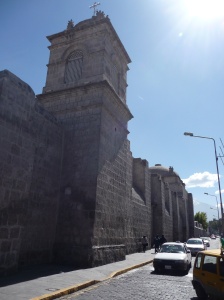






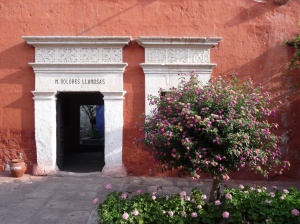














































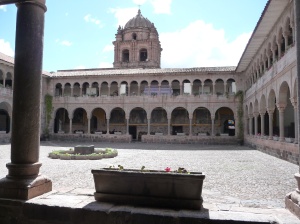


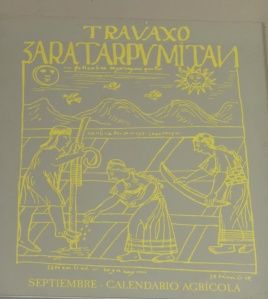


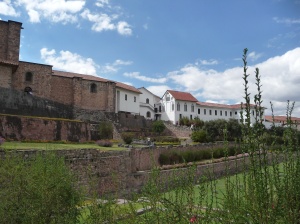



















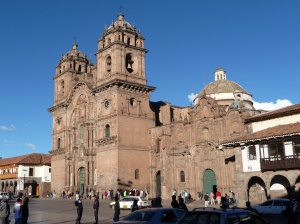


can’t wait to read more, xoxo Kaz